Applications of Decision Tree and Random Forest as Tree-Based Machine Learning Techniques for Analyzing the Ultimate Strain of Spliced and Non-Spliced Reinforcement Bars
Abstract
:1. Introduction
2. Methodology and Data Collection
3. Prediction Models
3.1. Decision Tree (DT)
3.2. Random Forest (RF)
4. Results
5. Accuracy Evaluation
6. Summary and Conclusions
- The results proved the high ability of both DT and RF models for learning the relationship between input variables and the output. The quick and simple ML-based models proposed in this study, therefore, could be considered as a reliable alternative approach for time-consuming and costly experimental tests.
- Both the DT and RF model exhibited highly reliable results, with R2 scores higher than 85%. The DT model, however, illustrated higher accuracy (R2 = 89%) compared to the RF model (R2 = 85%). It should be explained that although RF generally leads to more reliable results, in this study, the predicted values obtained by the DT model were more accurate, because the training and testing datasets for each model were selected randomly in order to avoid any human effect on the prediction process. In other words, the training and testing databases were not the same, which caused the slight difference between the models’ accuracy. In order to compare RF and DT more precisely, the same training and testing datasets should be chosen. This study, however, focused on the reliability assessment of Decision Tree and Random Forest models for estimating the ultimate strain of spliced and non-spliced steel bars, and the results proved their acceptable accuracy.
- It is also noteworthy that comparing the accuracy of the models, which estimates the ultimate strain of bars, for each splice method could be conducted in further studies. To this end, (a) an extensive database including the results of tests on each splice type should be collected; (b) input variables for each method should be specified—as an example, the strength of grout could be considered as one of the inputs for models estimating the mechanical properties of grouted spliced bars; and (c) the databases should be large enough for training the relationships between inputs (which may be different for each splice technique) and output appropriately.
- The proposed models in this research could be used in a more generalized model for predicting the stress-strain behavior of spliced and non-spliced bars. More clearly, by combining models which predict other parameters (e.g., yield strength and strain) with the models proposed in this study, the stress-strain curve could be estimated without doing experimental tests.
Author Contributions
Funding
Institutional Review Board Statement
Informed Consent Statement
Data Availability Statement
Conflicts of Interest
Nomenclature
| ANN | Artificial Neural Network |
| DT | Decision Tree |
| MAE | Mean of Absolute Error |
| MAPE | Mean of Percentage Error |
| ML | Machine Learning |
| MSE | Mean of Square Error |
| n | Number of datasets |
| RC | Reinforced Concrete |
| RF | Random Forest |
| RMSE | Root of Mean Square Error |
| Actual value | |
| Predicted value |
References
- Zhan, J.; Zhang, F.; Siahkouhi, M.; Kong, X.; Xia, H. A damage identification method for connections of adjacent box-beam bridges using vehicle–bridge interaction analysis and model updating. Eng. Struct. 2021, 228, 111551. [Google Scholar] [CrossRef]
- Zhao, E.; Song, C.; Zhang, X.; Zhou, Q.; Yan, K. Experimental study on monotonic, cyclic mechanics and fatigue performance of pressed cone sleeve splices. In Structures; Elsevier: Amsterdam, The Netherlands, 2022; pp. 482–495. [Google Scholar]
- Ghayeb, H.H.; Razak, H.A.; Sulong, N.R.; Mo, K.H.; Abutaha, F.; Gordan, M. Performance of mechanical steel bar splices using grouted couplers under uniaxial tension. J. Build. Eng. 2021, 34, 101892. [Google Scholar] [CrossRef]
- Zhang, P.; Su, Y.L.; Fan, J.J.; Feng, H.; Shao, J.; Guo, H.; Gao, D.-Y.; Sheikh, S.A. Experimental research on the mechanical behavior of grouted sleeves with fiber-reinforced grouting material under cyclic loading. In Structures; Elsevier: Amsterdam, The Netherlands, 2021; pp. 2189–2204. [Google Scholar]
- Xu, L.; Pan, J.; Guo, L. Mechanical performance of precast RC columns with grouted sleeve connections. Eng. Struct. 2022, 252, 113654. [Google Scholar] [CrossRef]
- Bompa, D.; Elghazouli, A. Ductility considerations for mechanical reinforcement couplers. In Structures; Elsevier: Amsterdam, The Netherlands, 2017; pp. 115–119. [Google Scholar]
- Wu, S.; Li, H.; Wang, X.; Li, R.; Tian, C.; Hou, Q. Seismic performance of a novel partial precast RC shear wall with reserved cast-in-place base and wall edges. Soil Dyn. Earthq. Eng. 2022, 152, 107038. [Google Scholar] [CrossRef]
- Alyousef, R.; Topper, T.; Al-Mayah, A. Crack growth modeling of tension lap spliced reinforced concrete beams strengthened with fibre reinforced polymer wrapping under fatigue loading. Constr. Build. Mater. 2018, 166, 345–355. [Google Scholar] [CrossRef]
- Dabiri, H.; Kheyroddin, A.; Dall’Asta, A. Splice methods used for reinforcement steel bars: A state-of-the-art review. Constr. Build. Mater. 2022, 320, 126198. [Google Scholar] [CrossRef]
- Dahal, P.K.; Tazarv, M. Mechanical bar splices for incorporation in plastic hinge regions of RC members. Constr. Build. Mater. 2020, 258, 120308. [Google Scholar] [CrossRef]
- Dabiri, H.; Kheyroddin, A. An experimental comparison of RC beam-column joints incorporating different splice methods in the beam. In Structures; Elsevier: Amsterdam, The Netherlands, 2021; pp. 1603–1613. [Google Scholar]
- Kheyroddin, A.; Rouhi, S.; Dabiri, H. An experimental study on the influence of incorporating lap or forging (GPW) splices on the cyclic performance of RC columns. Eng. Struct. 2021, 241, 112434. [Google Scholar] [CrossRef]
- Tazarv, M.; Saiidi, M.S. Seismic design of bridge columns incorporating mechanical bar splices in plastic hinge regions. Eng. Struct. 2016, 124, 507–520. [Google Scholar] [CrossRef]
- Lu, Z.; Huang, J.; Dai, S.; Liu, J.; Zhang, M. Experimental study on a precast beam-column joint with double grouted splice sleeves. Eng. Struct. 2019, 199, 109589. [Google Scholar] [CrossRef]
- Henin, E.; Morcous, G. Non-proprietary bar splice sleeve for precast concrete construction. Eng. Struct. 2015, 83, 154–162. [Google Scholar] [CrossRef]
- Sayadi, A.A.; Rahman, A.B.A.; Jumaat, M.Z.B.; Alengaram, U.J.; Ahmad, S. The relationship between interlocking mechanism and bond strength in elastic and inelastic segment of splice sleeve. Constr. Build. Mater. 2014, 55, 227–237. [Google Scholar] [CrossRef]
- Hosseini, S.J.A.; Rahman, A.B.A.; Osman, M.H.; Saim, A.; Adnan, A. Bond behavior of spirally confined splice of deformed bars in grout. Constr. Build. Mater. 2015, 80, 180–194. [Google Scholar] [CrossRef]
- Lin, F.; Wu, X. Mechanical performance and stress–strain relationships for grouted splices under tensile and cyclic loadings. Int. J. Concr. Struct. Mater. 2016, 10, 435–450. [Google Scholar] [CrossRef] [Green Version]
- Bompa, D.; Elghazouli, A. Monotonic and cyclic performance of threaded reinforcement splices. In Structures; Elsevier: Amsterdam, The Netherlands, 2018; pp. 358–372. [Google Scholar]
- Bompa, D.; Elghazouli, A. Elevated temperature characteristics of steel reinforcement incorporating threaded mechanical couplers. Fire Saf. J. 2019, 104, 8–21. [Google Scholar] [CrossRef] [Green Version]
- Borrero, E.L.; Farhangi, V.; Jadidi, K.; Karakouzian, M. An Experimental Study on Concrete’s Durability and Mechanical Characteristics Subjected to Different Curing Regimes. Civ. Eng. J. 2021, 7, 676–689. [Google Scholar] [CrossRef]
- ASTM E8/E8M-16; Standard Test Methods for Tension Testing of Metallic Materials. ASTM International: West Conshohocken, PA, USA, 2018.
- Shariati, M.; Mafipour, M.S.; Ghahremani, B.; Azarhomayun, F.; Ahmadi, M.; Trung, N.T.; Shariati, A. A novel hybrid extreme learning machine–grey wolf optimizer (ELM-GWO) model to predict compressive strength of concrete with partial replacements for cement. Eng. Comput. 2020, 38, 757–779. [Google Scholar] [CrossRef]
- Kandiri, A.; Golafshani, E.M.; Behnood, A. Estimation of the compressive strength of concretes containing ground granulated blast furnace slag using hybridized multi-objective ANN and salp swarm algorithm. Constr. Build. Mater. 2020, 248, 118676. [Google Scholar] [CrossRef]
- Golafshani, E.M.; Rahai, A.; Sebt, M.H.; Akbarpour, H. Prediction of bond strength of spliced steel bars in concrete using artificial neural network and fuzzy logic. Constr. Build. Mater. 2012, 36, 411–418. [Google Scholar] [CrossRef]
- Dabiri, H.; Rahimzadeh, K.; Kheyroddin, A. A comparison of machine learning-and regression-based models for predicting ductility ratio of RC beam-column joints. In Structures; Elsevier: Amsterdam, The Netherlands, 2022; pp. 69–81. [Google Scholar]
- Khaleghi, M.; Salimi, J.; Farhangi, V.; Moradi, M.J.; Karakouzian, M. Evaluating the behaviour of centrally perforated unreinforced masonry walls: Applications of numerical analysis, machine learning, and stochastic methods. Ain Shams Eng. J. 2022, 13, 101631. [Google Scholar] [CrossRef]
- Dabiri, H.; Kheyroddin, A.; Faramarzi, A. Predicting tensile strength of spliced and non-spliced steel bars using machine learning-and regression-based methods. Constr. Build. Mater. 2022, 325, 126835. [Google Scholar] [CrossRef]
- Chou, P.-Y.; Tsai, J.-T.; Chou, J.-H. Modeling and optimizing tensile strength and yield point on a steel bar using an artificial neural network with taguchi particle swarm optimizer. IEEE Access 2016, 4, 585–593. [Google Scholar] [CrossRef]
- Moradi, M.; Daneshvar, K.; Ghazi-Nader, D.; Hajiloo, H. The prediction of fire performance of concrete-filled steel tubes (CFST) using artificial neural network. Thin-Walled Struct. 2021, 161, 107499. [Google Scholar] [CrossRef]
- Ben Seghier, M.E.A.; Ouaer, H.; Ghriga, M.A.; Menad, N.A.; Thai, D.-K. Hybrid soft computational approaches for modeling the maximum ultimate bond strength between the corroded steel reinforcement and surrounding concrete. Neural Comput. Appl. 2021, 33, 6905–6920. [Google Scholar] [CrossRef]
- Fu, B.; Chen, S.-Z.; Liu, X.-R.; Feng, D.-C. A probabilistic bond strength model for corroded reinforced concrete based on weighted averaging of non-fine-tuned machine learning models. Constr. Build. Mater. 2022, 318, 125767. [Google Scholar] [CrossRef]
- Jing, G.; Yunchang, D.; You, R.; Siahkouhi, M. Comparison study of crack propagation in rubberized and conventional prestressed concrete sleepers using digital image correlation. Proc. Inst. Mech. Eng. Part F J. Rail Rapid Transit 2021, 09544097211020595. [Google Scholar] [CrossRef]
- Kheyroddin, A.; Mohammadkhah, A.; Dabiri, H.; Kaviani, A. Experimental investigation of using mechanical splices on the cyclic performance of RC columns. In Structures; Elsevier: Amsterdam, The Netherlands, 2020; pp. 717–727. [Google Scholar]
- Bompa, D.; Elghazouli, A. Inelastic cyclic behaviour of RC members incorporating threaded reinforcement couplers. Eng. Struct. 2019, 180, 468–483. [Google Scholar] [CrossRef]
- Rowell, S.P.; Grey, C.E.; Woodson, S.C.; Hager, K.P. High Strain-Rate Testing of Mechanical Couplers; Engineer Research and Development Center Vicksburg MS Geotechnical and Structures Lab: Vicksburg, MS, USA, 2009. [Google Scholar]
- Jordan, E.J. Experimental Studies of Reinforcing Steel and Shape Memory Alloys in Mechanically Spliced Connections for Seismic Application; University of Nevada: Reno, NV, USA, 2018. [Google Scholar]
- Chidambaram, R.S.; Agarwal, P. Performance evaluation of innovative hybrid rebar coupler in reinforced concrete beams subjected to monotonic loading. Struct. Concr. 2018, 19, 892–903. [Google Scholar] [CrossRef]
- Lloyd, W. Qualification of the Bar-Lock Rebar Coupler for Use in Nuclear Safety-Related Applications Mechanical Testing Program and Performance Analysis; Report No. INEEL/EXT-02-01387; Idaho National Engineering and Environmental Laboratory Materials Department: Idaho Falls, ID, USA, 2001. [Google Scholar]
- Higgins, C.C.; Barbosa, A.; Shrestha, S.; Lostra, M.; Belejo, A. Seismic Retrofits for Square Reinforced Concrete Columns Using Titanium Alloy Bars; School of Civil and Construction Engineering, Oregon State University: Corvallis, OR, USA, 2020. [Google Scholar]
- ACI. Building Code Requirement for Structural Concrete and Commentary; American Concrete Institute Committee: Farmington Hills, MI, USA, 2019. [Google Scholar]
- Liu, S.; McGree, J.; Ge, Z.; Xie, Y. Computational and Statistical Methods for Analysing Big Data with Applications; Academic Press: Cambridge, MA, USA, 2015. [Google Scholar]
- Nisbet, R.; Elder, J.; Miner, G.D. Handbook of Statistical Analysis and Data Mining Applications; Academic Press: Cambridge, MA, USA, 2009. [Google Scholar]
- Bellini, T. IFRS 9 and CECL Credit Risk Modelling and Validation: A Practical Guide with Examples Worked in R and SAS; Academic Press: Cambridge, MA, USA, 2019. [Google Scholar]
- Xia, Y. Correlation and association analyses in microbiome study integrating multiomics in health and disease. Prog. Mol. Biol. Transl. Sci. 2020, 171, 309–491. [Google Scholar]
- Gedeck, P.; Kramer, C.; Ertl, P. Computational analysis of structure–activity relationships. Prog. Med. Chem. 2010, 49, 113–160. [Google Scholar]
- Fawagreh, K.; Gaber, M.M.; Elyan, E. Random forests: From early developments to recent advancements. Syst. Sci. Control Eng. Open Access J. 2014, 2, 602–609. [Google Scholar] [CrossRef] [Green Version]
- Breiman, L. Random forests. Mach. Learn. 2001, 45, 5–32. [Google Scholar] [CrossRef] [Green Version]
- Breiman, L. Bagging predictors. Mach. Learn. 1996, 24, 123–140. [Google Scholar] [CrossRef] [Green Version]
- Amit, Y.; Geman, D. Shape quantization and recognition with randomized trees. Neural Comput. 1997, 9, 1545–1588. [Google Scholar] [CrossRef] [Green Version]
- Daneshvar, K.; Moradi, M.J.; Amooie, M.; Chen, S.; Mahdavi, G.; Hariri-Ardebili, M.A. Response of low-percentage FRC slabs under impact loading: Experimental, numerical, and soft computing methods. In Structures; Elsevier: Amsterdam, The Netherlands, 2020; pp. 975–988. [Google Scholar]
- Moradi, M.J.; Hariri-Ardebili, M.A. Developing a library of shear walls database and the neural network based predictive meta-model. Appl. Sci. 2019, 9, 2562. [Google Scholar] [CrossRef] [Green Version]
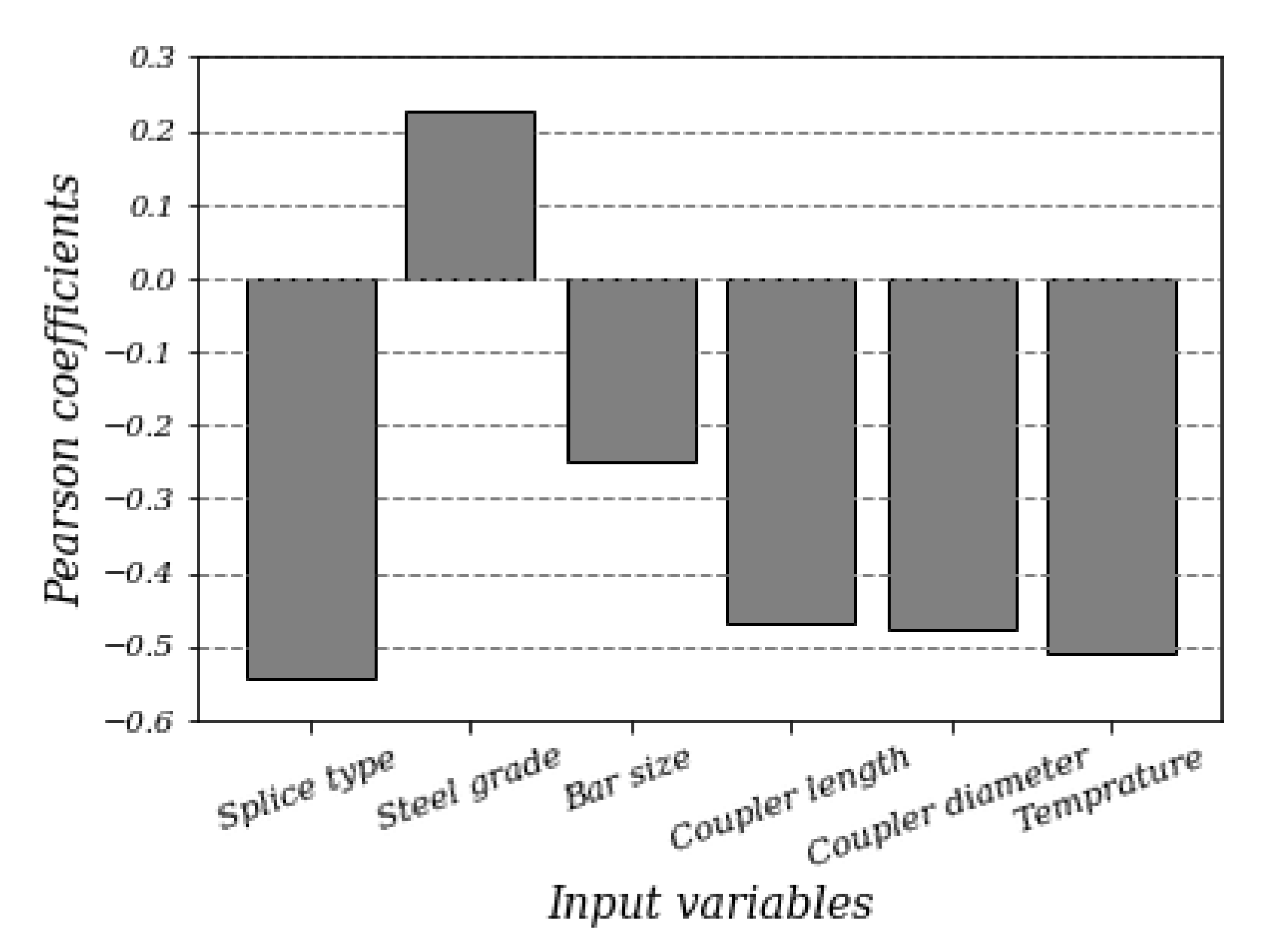
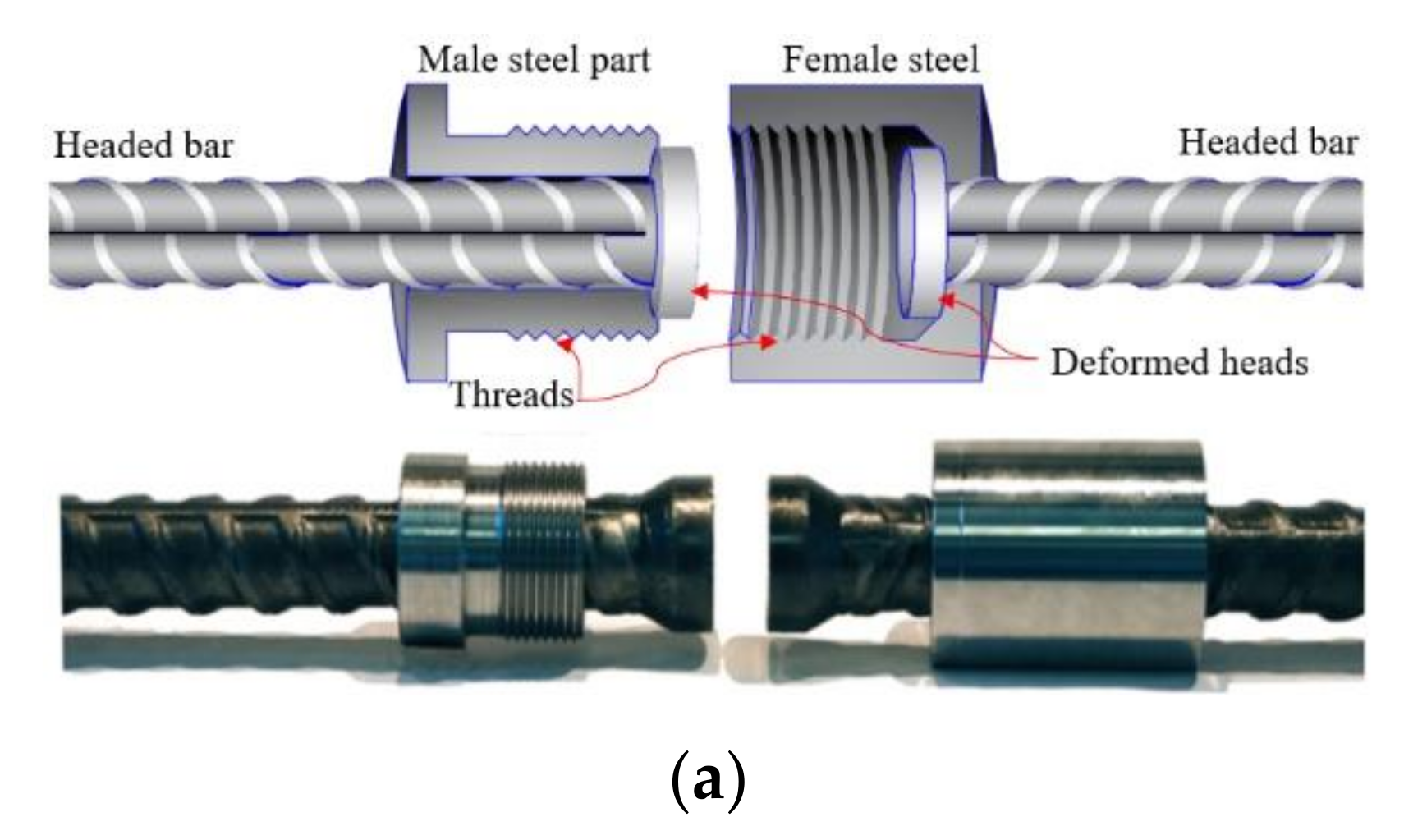
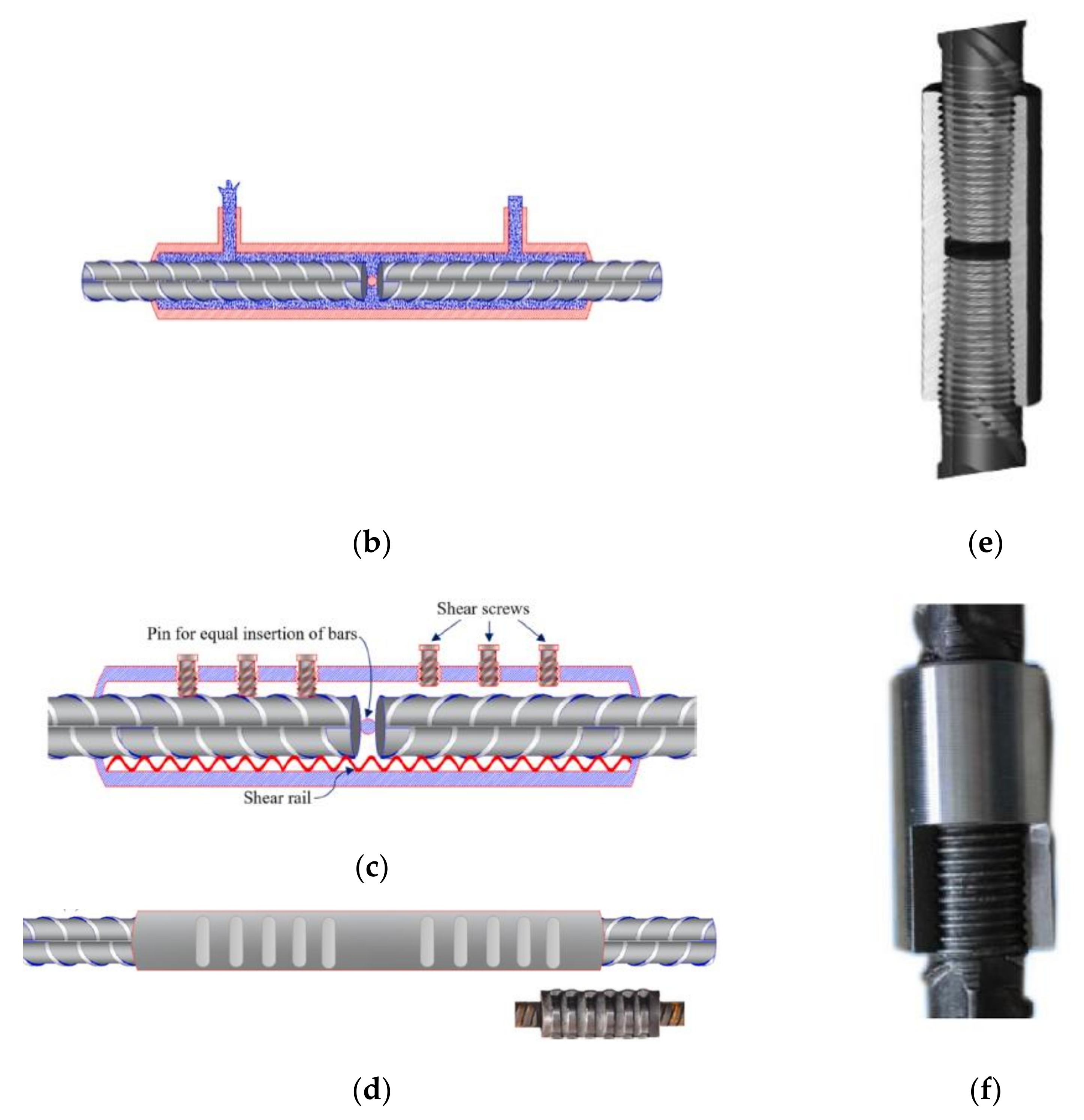

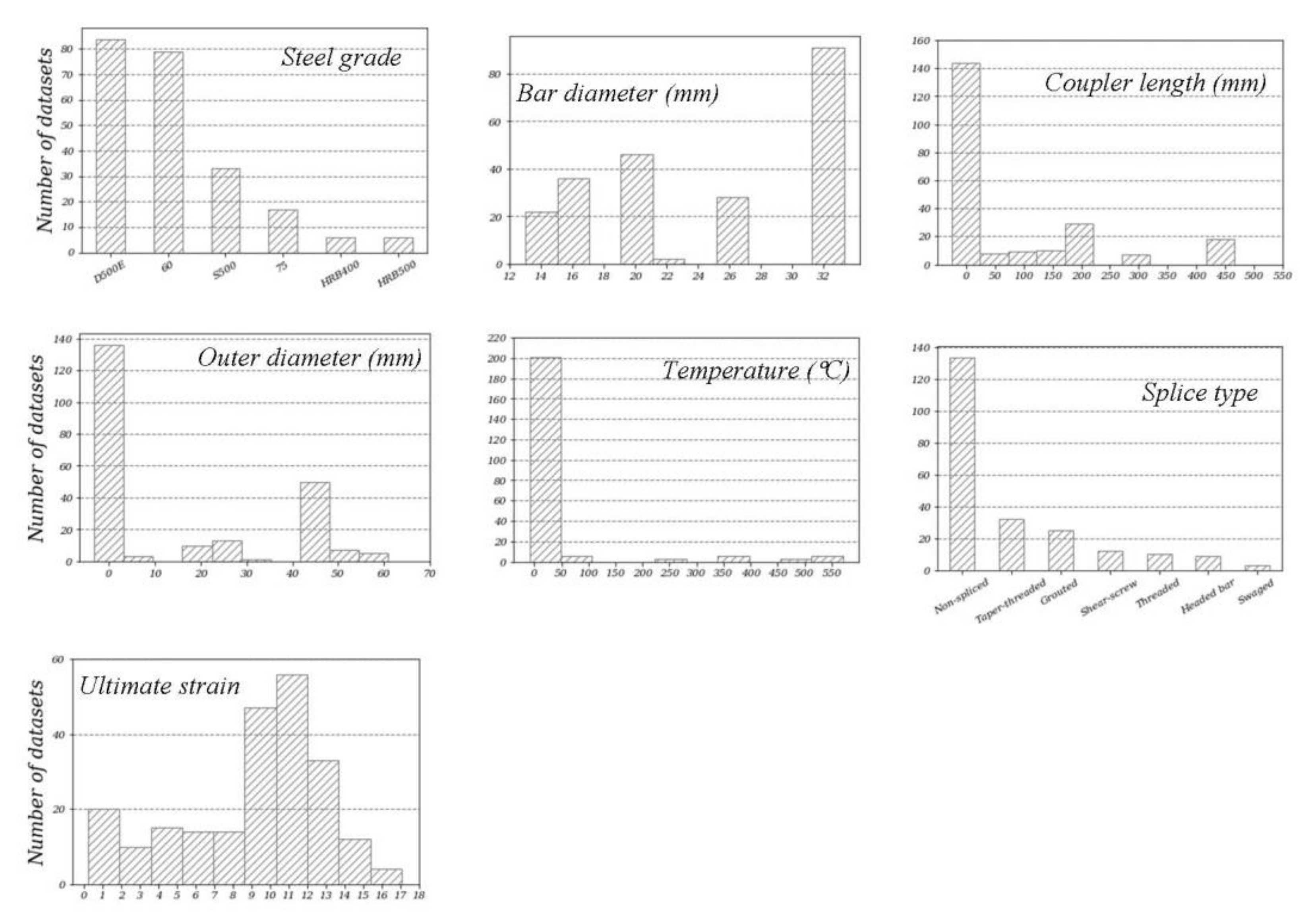
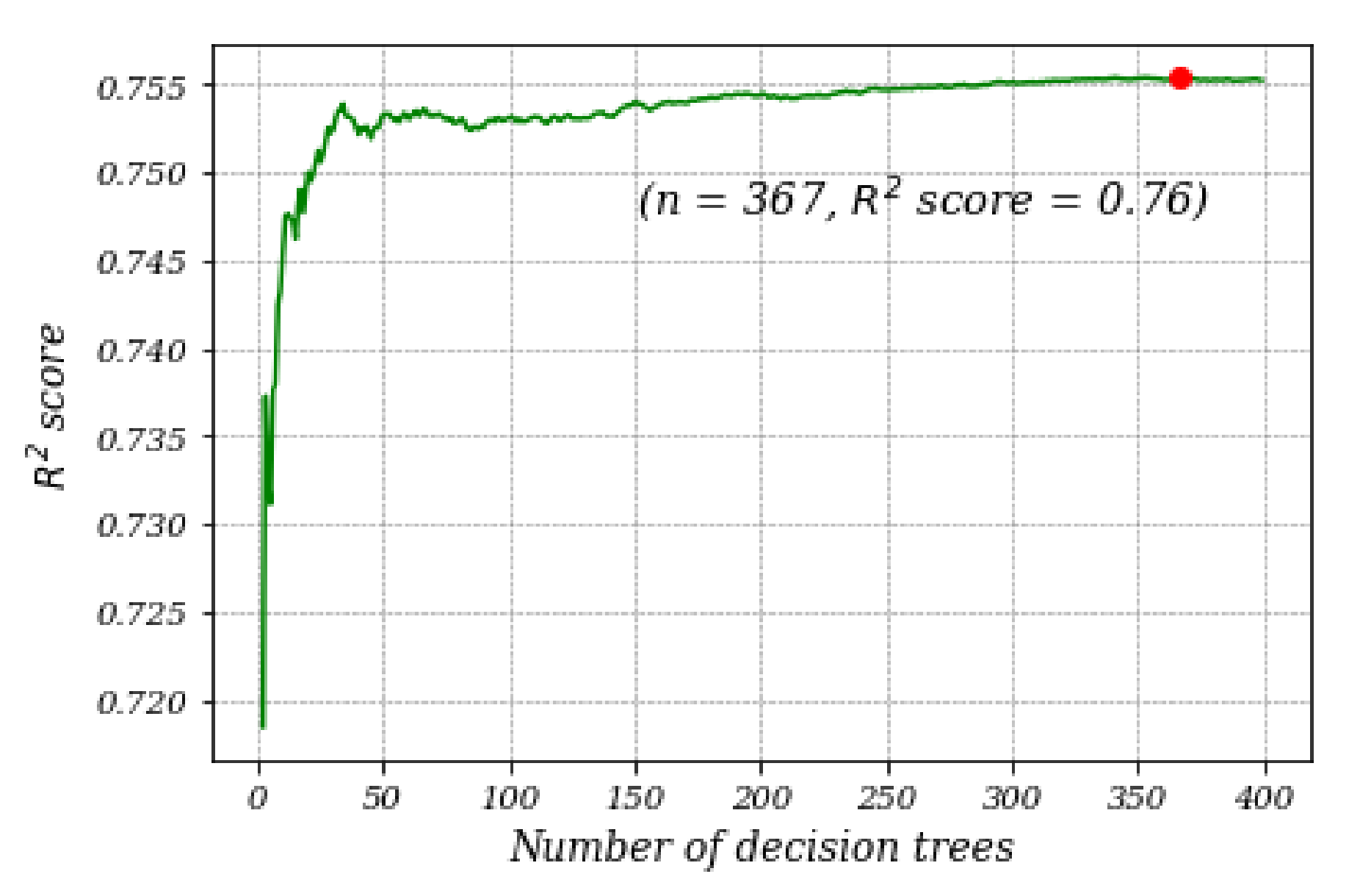
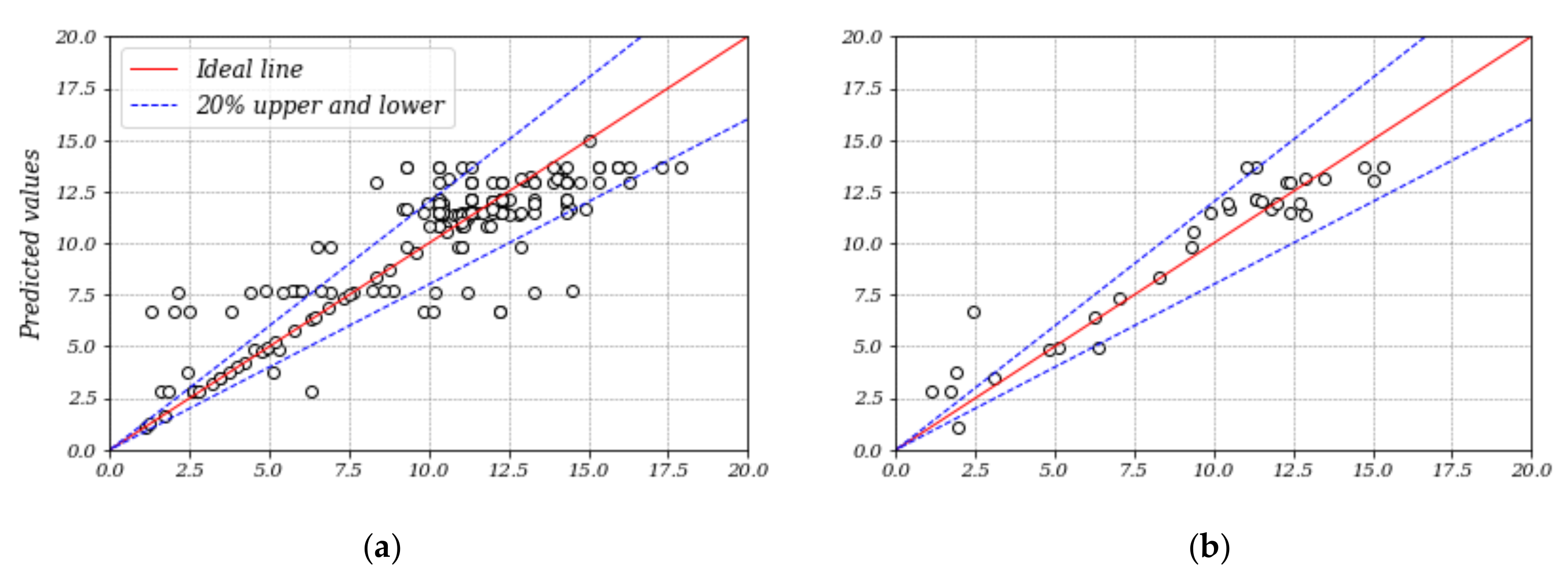

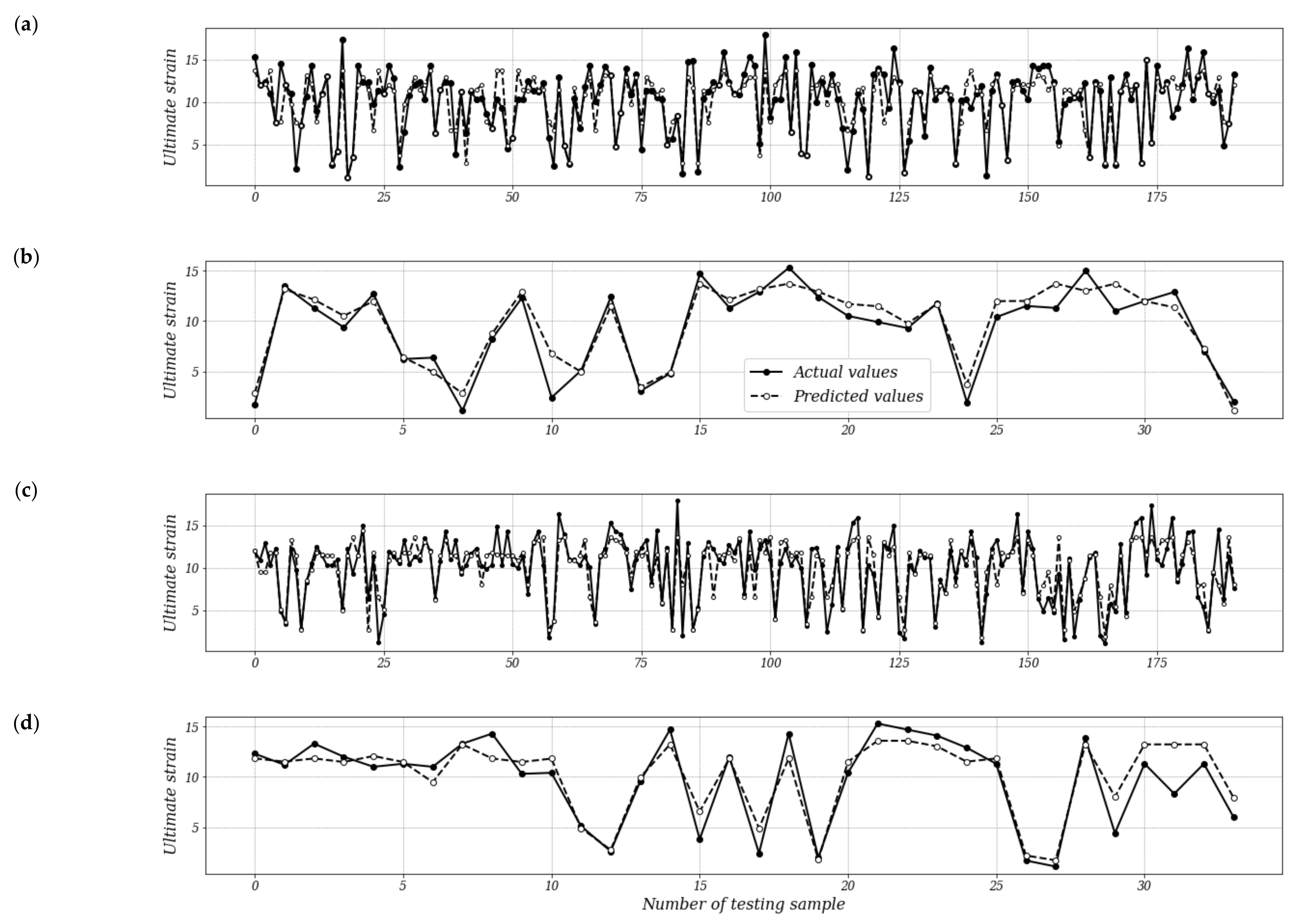
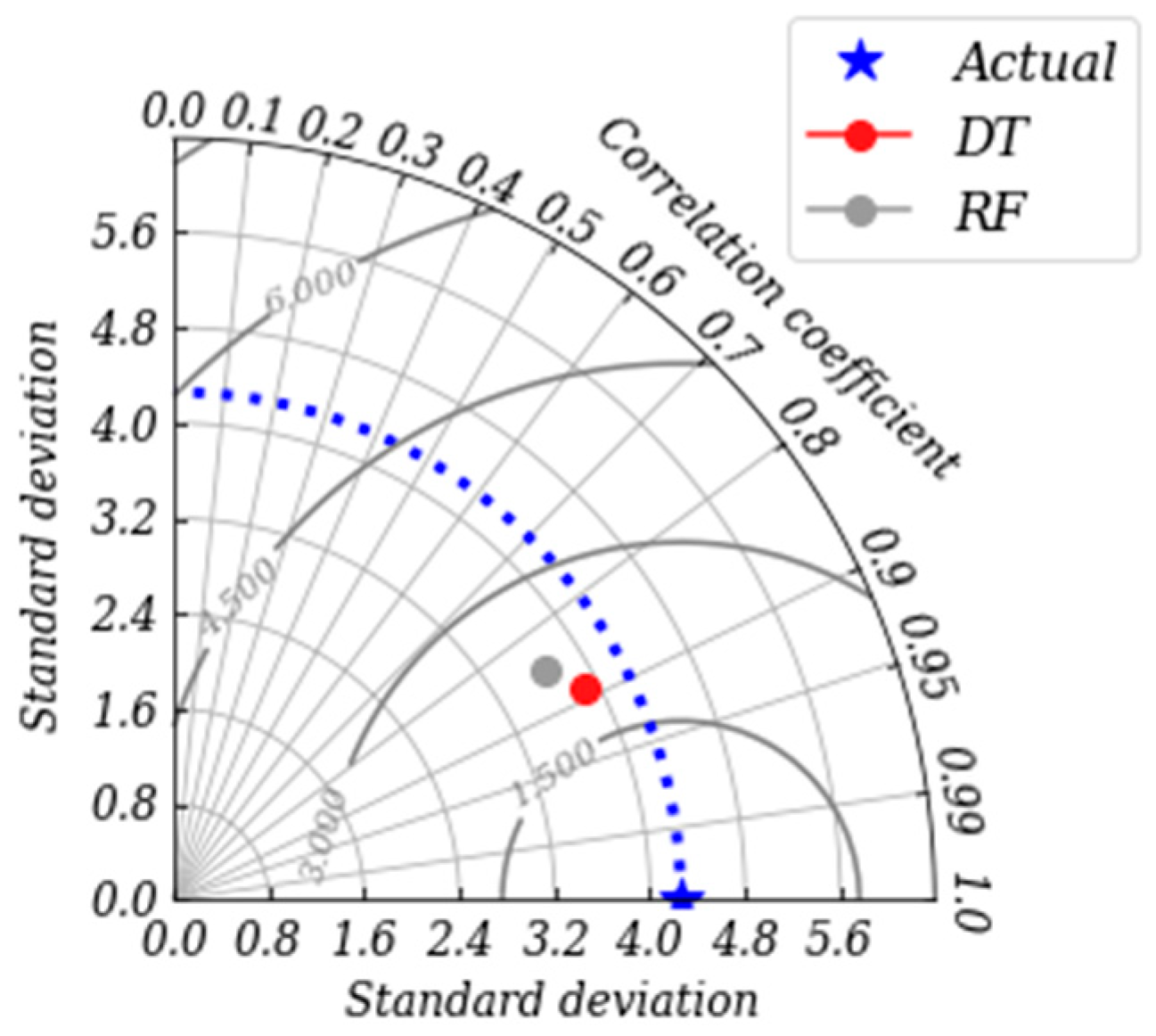
| Splice Type | Steel Grade | Bar Diameter (mm) | Length of Coupler (mm) | Outer Diameter of Coupler (mm) | Temperature | Ultimate Strain (%) | |
|---|---|---|---|---|---|---|---|
| Splice type | 1 | ||||||
| Steel grade | −0.2903 | 1 | |||||
| Bar diameter (mm) | 0.1202 | −0.6783 | 1 | ||||
| Length of Coupler (mm) | 0.5919 | −0.5424 | 0.3494 | 1 | |||
| Outer diameter of Coupler (mm) | 0.7556 | −0.6306 | 0.3811 | 0.818 | 1 | ||
| Temperature | 0.2882 | 0.2681 | −0.2307 | −0.0025 | 0.0257 | 1 | |
| Ultimate strain (%) | −0.541 | 0.2281 | −0.2471 | −0.4698 | −0.4781 | −0.5092 | 1 |
| Minimum | Maximum | Mean | Median | Variance | Standard Deviation | |
|---|---|---|---|---|---|---|
| Steel grade | 60.00 | 500.00 | 310.73 | 500.00 | 46,272.79 | 215.11 |
| Bar diameter (mm) | 12.00 | 32.26 | 24.16 | 25.00 | 55.25 | 7.43 |
| Coupler length (mm) | 45.00 | 490.54 | 88.80 | 0.00 | 20,316.91 | 142.54 |
| Coupler outer diameter (mm) | 7.29 | 64.00 | 17.23 | 0.00 | 519.34 | 22.79 |
| Temperature (°C) | 20.00 | 600.00 | 61.82 | 25.00 | 15,448.67 | 124.29 |
| Ultimate strain (%) | 1.08 | 17.90 | 9.93 | 11.00 | 15.33 | 3.92 |
| R2 | R | RMSE | MSE | MAE | MAPE | |
|---|---|---|---|---|---|---|
| DT | 0.89 | 0.94 | 1.38 | 1.90 | 1.04 | 23.25 |
| RF | 0.85 | 0.92 | 1.68 | 2.82 | 1.29 | 19.72 |
Publisher’s Note: MDPI stays neutral with regard to jurisdictional claims in published maps and institutional affiliations. |
© 2022 by the authors. Licensee MDPI, Basel, Switzerland. This article is an open access article distributed under the terms and conditions of the Creative Commons Attribution (CC BY) license (https://creativecommons.org/licenses/by/4.0/).
Share and Cite
Dabiri, H.; Farhangi, V.; Moradi, M.J.; Zadehmohamad, M.; Karakouzian, M. Applications of Decision Tree and Random Forest as Tree-Based Machine Learning Techniques for Analyzing the Ultimate Strain of Spliced and Non-Spliced Reinforcement Bars. Appl. Sci. 2022, 12, 4851. https://doi.org/10.3390/app12104851
Dabiri H, Farhangi V, Moradi MJ, Zadehmohamad M, Karakouzian M. Applications of Decision Tree and Random Forest as Tree-Based Machine Learning Techniques for Analyzing the Ultimate Strain of Spliced and Non-Spliced Reinforcement Bars. Applied Sciences. 2022; 12(10):4851. https://doi.org/10.3390/app12104851
Chicago/Turabian StyleDabiri, Hamed, Visar Farhangi, Mohammad Javad Moradi, Mehdi Zadehmohamad, and Moses Karakouzian. 2022. "Applications of Decision Tree and Random Forest as Tree-Based Machine Learning Techniques for Analyzing the Ultimate Strain of Spliced and Non-Spliced Reinforcement Bars" Applied Sciences 12, no. 10: 4851. https://doi.org/10.3390/app12104851
APA StyleDabiri, H., Farhangi, V., Moradi, M. J., Zadehmohamad, M., & Karakouzian, M. (2022). Applications of Decision Tree and Random Forest as Tree-Based Machine Learning Techniques for Analyzing the Ultimate Strain of Spliced and Non-Spliced Reinforcement Bars. Applied Sciences, 12(10), 4851. https://doi.org/10.3390/app12104851







